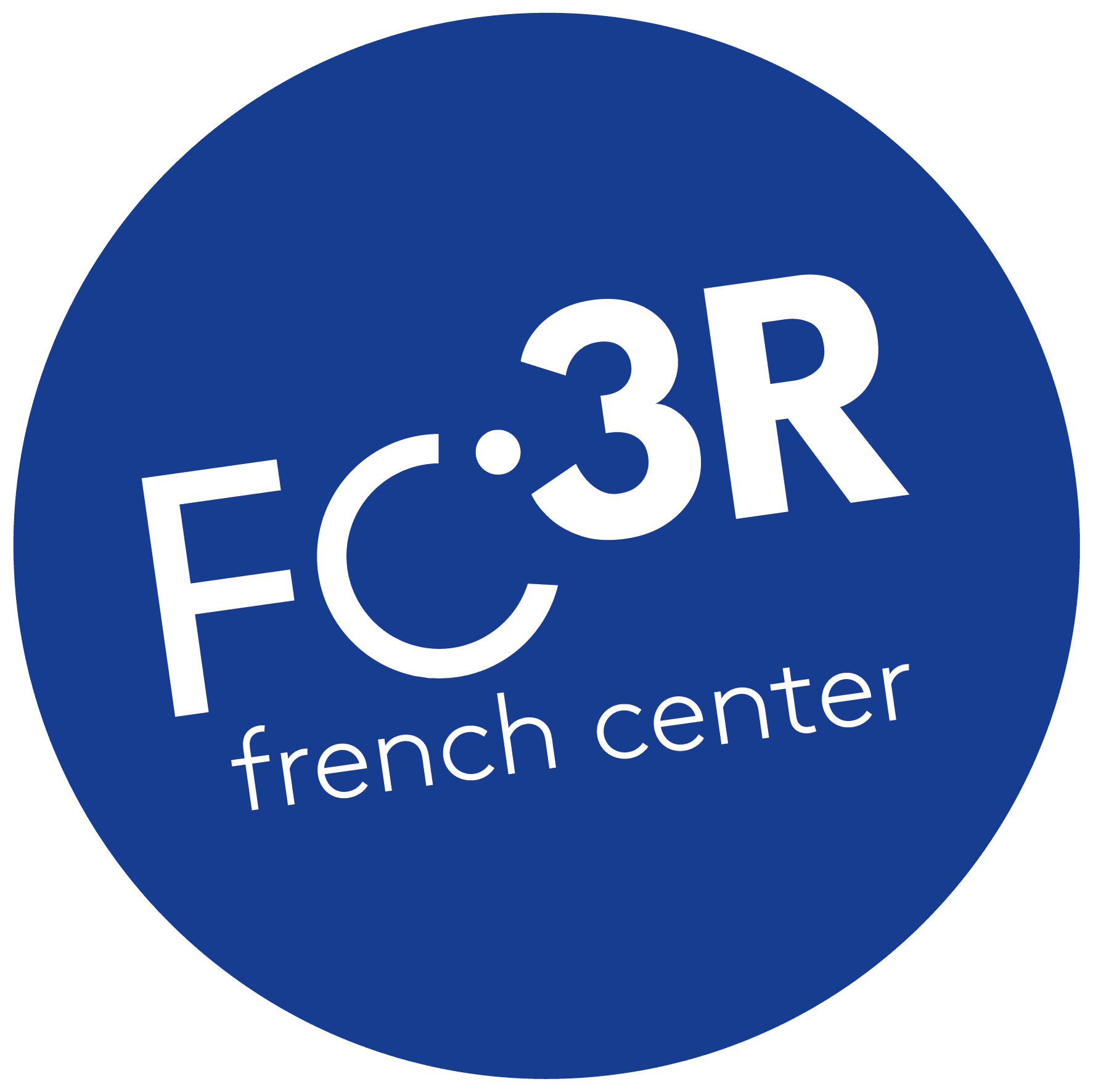The FC3R's mission is to promote and implement the 3Rs - Replace, Reduce and Refine - in France for the use of animals in scientific research. However, precise data on the effective use of alternative approaches to the use of vertebrate or cephalopod animals in accordance with directive 2010/63/EU remain limited. This is particularly true for methods designed to Replace animals, such as cell cultures, organs-on-a-chip, and in silico approaches. The expectations of researchers regarding the levers and obstacles to better adopting and implementing these approaches are also still poorly documented.
To gain a better understanding of the situation in France, an initial survey was carried out in 2023 by FC3R. The survey aimed to map the alternative approaches used in France, gather researchers' expectations, and obtain concrete data to define strategies that would facilitate the implementation of replacement practices in laboratories. In June 2023, the survey was distributed to the main public and private French research organizations. It covered respondents' profiles, research fields, current practices, and their perceptions and opinions. A total of 511 complete responses were analyzed.
Who responded to the survey?
The majority of respondents were women, representing 53% of the sample. Most participants were in the 35-40 (47%) and 51-64 (34%) age brackets.
A significant percentage of respondents (63%) are in research positions, including teacher-researchers, hospital practitioners, and postdoctoral researchers. Other represented categories are engineers and technicians (27%), students (7%) and other professionals (3%).
A total of 87 different entities are represented in the survey. Nearly 92% of respondents work in public research (including public establishments, foundations, and associations), while only 8% are employed in the private sector. This poor representation of the private sector limits the generalizability of the survey results.
Which research areas are being studied, and what alternative approaches are being used?
Most respondents' projects focus on basic research (46%) and translational and applied research (39%). Toxicological and regulatory studies account for 8% of responses, while training and education account for 6%.
More than half of all research areas (Figure 1) are concentrated on four main themes: the immune system and infectiology (14%), oncology (14%), the nervous and sensory systems (12%), and the gastrointestinal system and liver (10%). However, all major research fields and systems are represented. Therefore, the field of application of alternative methods is extremely vast and varied, reflecting the diversity of French research.
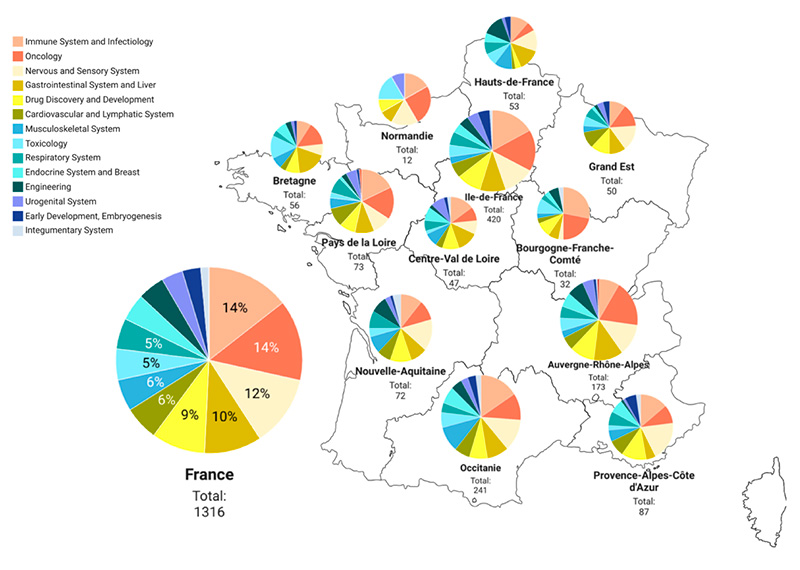
In addition, the survey revealed the use of a wide variety of alternative approaches throughout the country, including 2D Cultures" and "Organoids", which account for more than half the approaches used (54%). "In silico" digital approaches come in third. A few regional specificities are interesting to note. “In silico" approaches are over-represented in Provence-Alpes-Côte d'Azur and Nouvelle-Aquitaine, where they comprise 18% and 21% of responses, respectively, compared to an average of 13% in France. This could be due to specific research themes in these regions, such as the study of the nervous system (20% and 15%, respectively, versus 12% on average in France). This is an area of research that often involves numerical modeling (Figure 2).
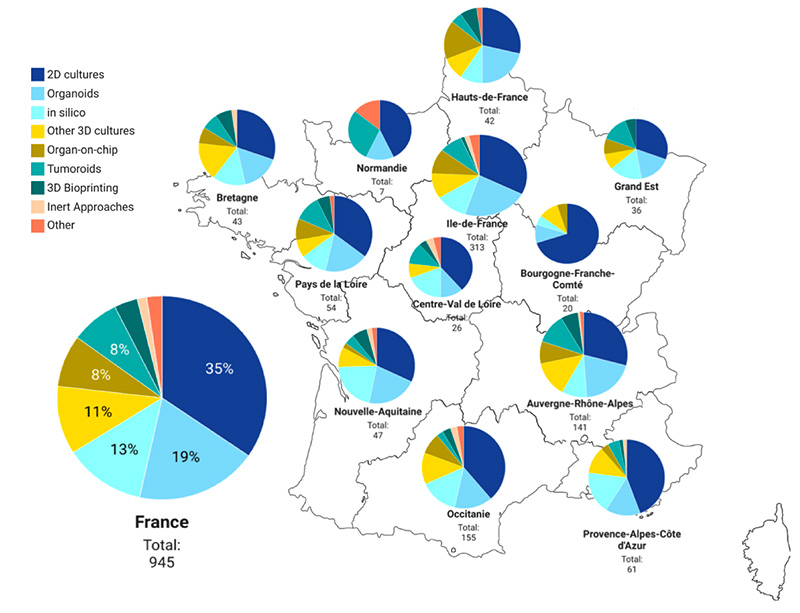
In what context are alternative approaches used in France?
Are surrogate approaches used in place of, or alongside, model organisms (vertebrates and cephalopods)? In other words, are researchers using multimodal approaches to address the scientific challenge at hand? To find out, we surveyed users of alternative methods about the possible use of animal methods. Interestingly, 75% of respondents use surrogate methods in addition to animal methods, 22% use surrogate methods exclusively, and 3% use invertebrates, as well as larval and fetal forms not covered by Directive 2010/63/EU. Although the latter are considered a "relative replacement" at the European level, they have been classified differently in this report due to the growing ethical concerns associated with certain classes of animals, notably insects. (Figure 3, central diagram)
Respondents using complementary methods mainly study the immune system and infectiology (16%), oncology (14%) and the nervous and sensory systems (13%). Those using exclusively non-animal methods work mainly in oncology (16%), the nervous and sensory systems (11%) and engineering (11%). These results indicate that complementary and non-animal methods (only) have different scientific priorities. (Figure 3, side diagrams)
For example, only 9% of respondents using exclusively non-animal methods study the immune system and infectiology, compared with 16% of respondents using complementary methods (non-animal and animal). This suggests that some scientific disciplines rely more heavily on the use of model organisms and complex, integrated living systems than others do.
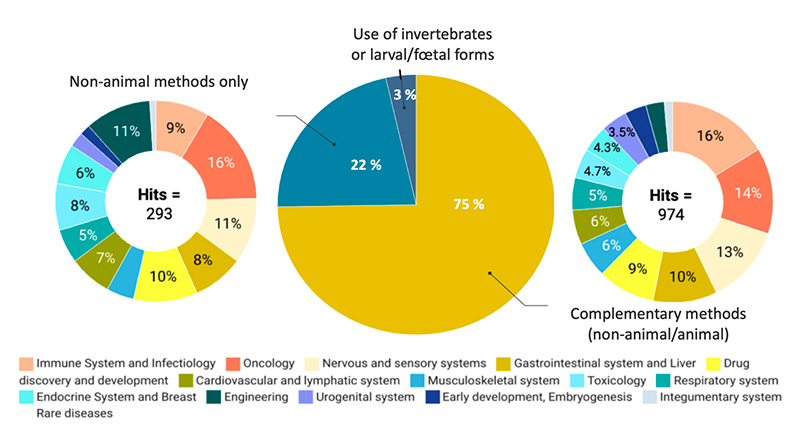
Regarding the nature of the alternative approaches used, respondents using complementary methods mainly resort to 2D cell culture (40%), while those using exclusively non-animal methods favor more complex approaches, such as Micro Physiological Systems(MPS), organoids, 3D cell cultures, microfluidic systems (e.g. organ-on-a-chip), tumoroids, and bioprinting ( 66% vs. 43% for the complementary methods group).
This distribution suggests that using complex in vitro cell culture systems (MPS) requires specialization and a higher level of technical and technological expertise, which may be difficult to attain without the necessary skills. The development and widespread use of MPS could be facilitated by setting up dedicated platforms and collaborations. (Figure 4)
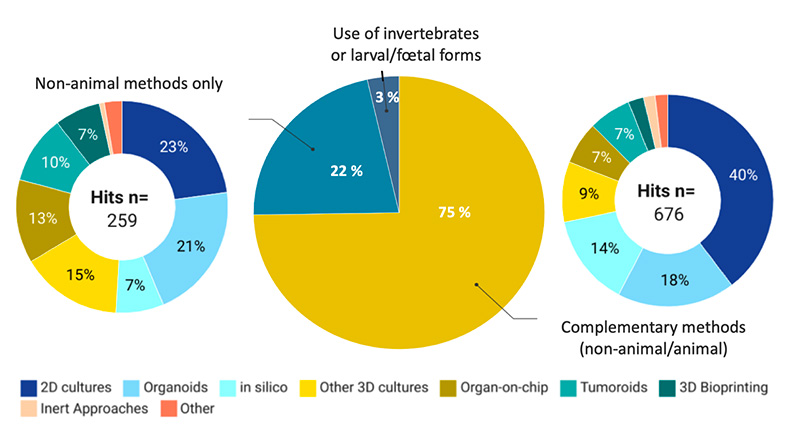
What are the levers and obstacles for implementing alternative methods?
The researchers' main expectations for developing alternative methods are, in order of importance, financial resources, the sharing of resources and knowledge, and the development of specific training courses.
Since 2022, the FC3R has funded approximately forty projects targeting alternative methods (see the results of the latest call for projects on Replacement, which have just been published). The FC3R’s mission is also to disseminate training offers, support the search for skills in replacement methods (see AREA, the directory of skills in alternative approaches), and promote the sharing of all results, positive or negative, through its Short Notes platform.
The France 2030 program has given high priority to alternative approaches, funding the "PEPR MED-OOC" in 2024. At the European level, Horizon Europe programs such as "Innovative non-animal human base tools and strategies fos biomedical research" have been launched. These programs could encourage the implementation of alternative methods in France and the European Union.
On the other side of the Atlantic, the United States continues to make significant advances in the field of alternative methods. In April 2025, the U.S. Food and Drug Administration (FDA) announced its intention to phase out animal testing in the development of monoclonal antibodies and other drugs, replacing them, for example, with AI models or organ-on-a-chip systems. This policy of change aligns with the FDA Modernization Act of 2022, which authorized for the first time the use of alternative methods in preclinical testing, without recourse to animals.
The survey carried out in 2023 by the FC3R attracted a high level of participation, mainly from researchers, and enabled us to compile this overview of alternative approaches used in academic research in France. It also highlighted levers that can encourage the adoption of these approaches. To refine replacement strategies, a longitudinal study is necessary to monitor the evolution of these practices and define more relevant strategies that support the transition to research using fewer animals.
